稳定型心绞痛的中医证型分析
如何中医治疗冠心病心绞痛

· 科普与经验交流 ·1252020年 第29期探头对微小的包块、病变都能进行扫描并显示在影像学图像中。
进行阴道超声检查前不需要膀胱充盈,不需要患者憋尿,此外也不会受到脂肪、肠气等因素影响。
近年来由于科学技术的不断发展,超声技术的不断发展,超声探头的分辨率也在越来越高,频率不断加大,这样就促使超声图像越来越清晰。
但是同腹部超声检查一样,阴道超声检查也存在一定的局限性,如使用阴道超声检查盆腔外包块或肝脾周围积液就不能清晰的表现,其检查的结果准确性有所降低。
阴道超声的优点相对较多,它不需要憋尿,不需要等待,为患者减轻憋尿的痛苦,节约检查时间;对于肥胖病人,不需要经过腹部多层组织及脂肪,减少声束吸收,图像较经腹超声清晰;对于前位及后位子宫的显示满意,对卵巢、输卵管及盆腔微小病变显示清晰,对血流信号敏感,更容易引出血流频谱,有利于妇产科疾病鉴别诊断;对盆腔小包块、盆腔积液显示满意,有利于早期诊断异位妊娠;经阴道超声引导下穿刺可用于盆腔肿物及附件肿物的穿刺活检。
三、阴道超声和腹部超声的比较1.异位妊娠的诊断(1)阴道超声检查:阴道超声检查属于腔内超声检查,这种检查方式突出的优点就是可以将高频探头伸入到患者阴道内穹窿部位,可以对子宫以及子宫周围进行仔细扫描,同时扫描过程中受到肠道内气体、腹壁脂肪、膀胱是否充盈、腹部手术瘢痕等影响较小。
同时阴道超声检查的高频探头比腹部超声检查探头要更小、更灵活,可以从多个方面对患者进行扫描,因此影像学图像更为清晰。
患者进行检查时无需憋尿,这样既缩短了检查的时间,也不会因此影响到检查的判断结果。
(2)腹部超声检查。
对异位妊娠的患者进行腹部超声检查突出的优点就是探测范围较广,但是存在众多缺点如:探头分辨率较低,探头临近的部位与子宫、子宫周围组织相差太远,扫描时探头容易受到患者腹壁厚度、膀胱不够充盈、有肠内气体等影响;由于子宫等部位解剖结构比较复杂,因此使用腹部超声检查时存在一定的盲区,如探头难以扫描到卵黄囊、妊娠囊等组织结构难以发现子宫周围微小的包块。
2012—2022年中医药治疗稳定型心绞痛的研究进展
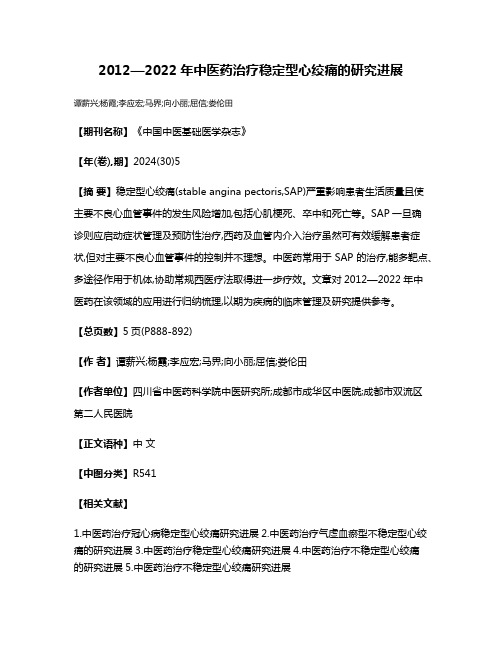
2012—2022年中医药治疗稳定型心绞痛的研究进展
谭薪兴;杨霞;李应宏;马界;向小丽;屈信;娄伦田
【期刊名称】《中国中医基础医学杂志》
【年(卷),期】2024(30)5
【摘要】稳定型心绞痛(stable angina pectoris,SAP)严重影响患者生活质量且使主要不良心血管事件的发生风险增加,包括心肌梗死、卒中和死亡等。
SAP一旦确
诊则应启动症状管理及预防性治疗,西药及血管内介入治疗虽然可有效缓解患者症状,但对主要不良心血管事件的控制并不理想。
中医药常用于SAP的治疗,能多靶点、多途径作用于机体,协助常规西医疗法取得进一步疗效。
文章对2012—2022年中
医药在该领域的应用进行归纳梳理,以期为疾病的临床管理及研究提供参考。
【总页数】5页(P888-892)
【作者】谭薪兴;杨霞;李应宏;马界;向小丽;屈信;娄伦田
【作者单位】四川省中医药科学院中医研究所;成都市成华区中医院;成都市双流区
第二人民医院
【正文语种】中文
【中图分类】R541
【相关文献】
1.中医药治疗冠心病稳定型心绞痛研究进展
2.中医药治疗气虚血瘀型不稳定型心绞痛的研究进展
3.中医药治疗稳定型心绞痛研究进展
4.中医药治疗不稳定型心绞痛
的研究进展5.中医药治疗不稳定型心绞痛研究进展
因版权原因,仅展示原文概要,查看原文内容请购买。
冠心病稳定型心绞痛中医诊疗指南
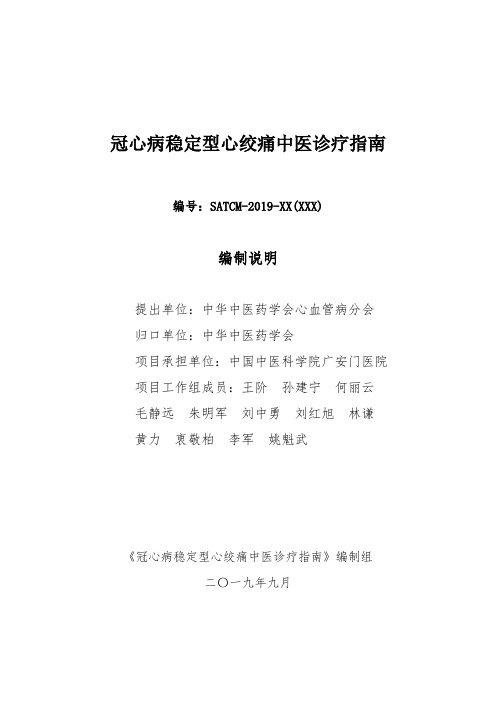
冠心病稳定型心绞痛中医诊疗指南编号:SATCM-2019-XX(XXX)编制说明提出单位:中华中医药学会心血管病分会归口单位:中华中医药学会项目承担单位:中国中医科学院广安门医院项目工作组成员:王阶孙建宁何丽云毛静远朱明军刘中勇刘红旭林谦黄力衷敬柏李军姚魁武《冠心病稳定型心绞痛中医诊疗指南》编制组二〇一九年九月目录一、背景介绍........................................ 错误!未定义书签。
(一)任务背景.................................... 错误!未定义书签。
(二)任务参加单位................................ 错误!未定义书签。
二、专家委员会及工作组.............................. 错误!未定义书签。
(一)指南指导委员会.............................. 错误!未定义书签。
(二)方法学专家.................................. 错误!未定义书签。
(三)疾病领域专家委员会.......................... 错误!未定义书签。
(四)主要起草人.................................. 错误!未定义书签。
(五)系统评价组.................................. 错误!未定义书签。
(六)秘书处...................................... 错误!未定义书签。
三、主要工作过程.................................... 错误!未定义书签。
(一)启动........................................ 错误!未定义书签。
(二)起草........................................ 错误!未定义书签。
冠心病稳定型心绞痛中医证型与血管内皮功能相关性研究
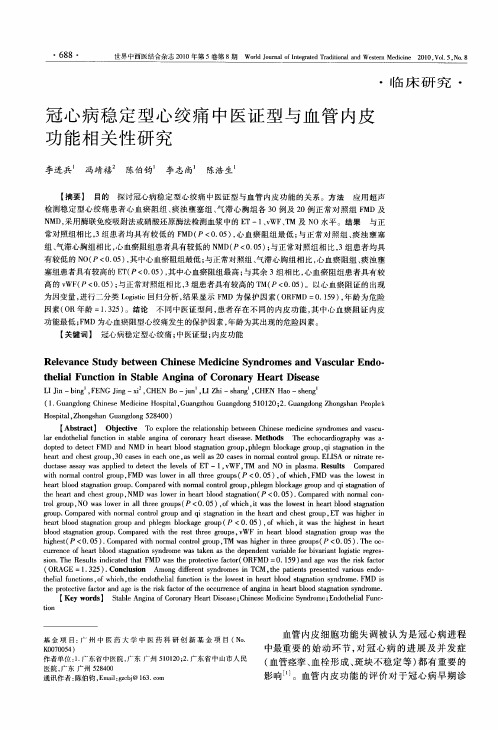
组、 气滞心胸组相 比, 心血瘀阻组患者具 有较低 的 N MD( 0 0 ) 与正常对照组相 比, P< .5 ; 3组患者均具
有较低的 N ( 00 )其 中心血瘀阻组最低 ; O P< .5 , 与正常对照组 、 气滞心胸组相 比, 心血瘀阻组 、 痰浊壅
塞组患者具有较 高的 E ( 00 ) 其 中心血瘀阻组最高 ; T P< .5 , 与其 余 3组相 比, 心血瘀 阻组 患者具有较
t la nc i n i a e An i f Co o a y H e r s a e hei lFu to n St bl g na o r n r a tDie s
L i bn F N i x , H N B — a L h —s a g , H N H o h n I n— i , E G J g— i C E o jn , I i h n C E a —se g J g n Z ( . u n d n hn s d ieH si lG a gh uG a g o g5 0 2 ; . u n d n h n s a e pe 1 G a g o gC ieeMe i n opt , u n z o u n d n 1 10 2 G a g o gZ o gh n P o lg c a H si lZ o gh n G a g o g5 8 0 ) opt , h n s a u n d n 2 4 0 a
高 的 v ( 0 0 ) 与正常对照组相 比, 组患者具有较高的 T P< .5 。以心血瘀 阻证 的出现 WF P< .5 ; 3 M( 0 0 ) 为因变量 , 进行二分类 Lg t oii s c回归分析 , 结果显示 F MD为保 护因素 ( R MD=0 19 , OF .5 ) 年龄为危 险 因素( R年龄 =135 。结论 O .2 ) 不 同中医证型 间, 患者存在 不 同的内皮 功能 , 其中心血瘀 阻证 内皮 功能最低 ;MD为心血瘀 阻型心绞痛发生的保护 因素 , F 年龄为其 出现 的危险因素。
加味瓜蒌薤白半夏汤治疗气虚痰瘀型胸痹(稳定型心绞痛)的临床观察

加味瓜蒌薤白半夏汤治疗气虚痰瘀型胸痹(稳定型心绞痛)的临床观察加味瓜蒌薤白半夏汤治疗气虚痰瘀型胸痹(稳定型心绞痛)的临床观察摘要:胸痹(稳定型心绞痛)是一种常见的心脑血管疾病,气虚痰瘀型胸痹是胸痹的一种常见病理类型。
本研究旨在探讨加味瓜蒌薤白半夏汤在治疗气虚痰瘀型胸痹中的临床疗效。
通过对30例气虚痰瘀型胸痹患者应用加味瓜蒌薤白半夏汤进行治疗,观察其临床症状、心电图改善情况以及患者生活质量的改善情况。
结果显示,加味瓜蒌薤白半夏汤可明显改善患者的心绞痛症状,减轻心电图异常,同时提高患者的生活质量。
因此,本研究认为加味瓜蒌薤白半夏汤可以作为治疗气虚痰瘀型胸痹的有效方剂。
关键词:加味瓜蒌薤白半夏汤;气虚痰瘀型;胸痹;心绞痛;治疗引言:胸痹(稳定型心绞痛)是由于冠状动脉狭窄或阻塞引起的心肌缺血病变,临床表现为心前区疼痛或压迫感。
气虚痰瘀型胸痹是胸痹的一种常见病理类型,主要表现为气虚、痰瘀等病理变化。
传统中医药学认为气虚痰瘀型胸痹的发生与气血运行不畅、气滞血瘀、痰火内蓄等有关。
方法:选取2019年至2020年期间就诊的30例气虚痰瘀型胸痹患者,其中男性18例,女性12例,年龄范围为42-70岁,平均年龄为57.3岁。
所有患者均有明确的诊断,包括典型心绞痛症状、心电图异常等。
排除其他心脑血管疾病、肺、肝、肾功能异常者及对试验方剂过敏者。
所有患者在西医药治疗基础上,给予加味瓜蒌薤白半夏汤治疗。
治疗方案:加味瓜蒌薤白半夏汤由以下药物组成:瓜蒌10g、生半夏30g、法半夏10g、薤白10g、陈皮6g、葛根10g、川芎10g、广藿香6g、川楝子10g、板蓝根10g、桑白皮6g、阿胶10g。
将以上中药煎煮后,取汁液口服,每日2次,连续治疗3个月。
临床观察:观察患者临床症状、心电图改善情况以及患者生活质量的改善情况。
治疗后,患者心前区疼痛明显减轻或消失,心电图异常也有一定程度的改善。
部分患者的生活质量调查也显示明显的改善。
冠心病稳定型心绞痛中医诊疗指南
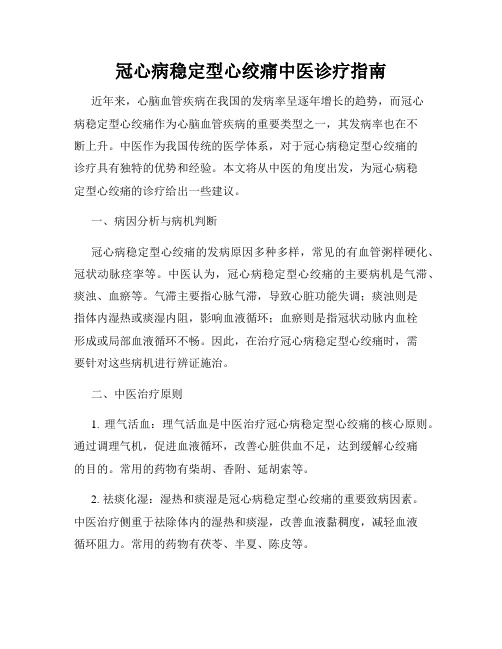
冠心病稳定型心绞痛中医诊疗指南近年来,心脑血管疾病在我国的发病率呈逐年增长的趋势,而冠心病稳定型心绞痛作为心脑血管疾病的重要类型之一,其发病率也在不断上升。
中医作为我国传统的医学体系,对于冠心病稳定型心绞痛的诊疗具有独特的优势和经验。
本文将从中医的角度出发,为冠心病稳定型心绞痛的诊疗给出一些建议。
一、病因分析与病机判断冠心病稳定型心绞痛的发病原因多种多样,常见的有血管粥样硬化、冠状动脉痉挛等。
中医认为,冠心病稳定型心绞痛的主要病机是气滞、痰浊、血瘀等。
气滞主要指心脉气滞,导致心脏功能失调;痰浊则是指体内湿热或痰湿内阻,影响血液循环;血瘀则是指冠状动脉内血栓形成或局部血液循环不畅。
因此,在治疗冠心病稳定型心绞痛时,需要针对这些病机进行辨证施治。
二、中医治疗原则1. 理气活血:理气活血是中医治疗冠心病稳定型心绞痛的核心原则。
通过调理气机,促进血液循环,改善心脏供血不足,达到缓解心绞痛的目的。
常用的药物有柴胡、香附、延胡索等。
2. 祛痰化湿:湿热和痰湿是冠心病稳定型心绞痛的重要致病因素。
中医治疗侧重于祛除体内的湿热和痰湿,改善血液黏稠度,减轻血液循环阻力。
常用的药物有茯苓、半夏、陈皮等。
3. 温肾壮阳:冠心病稳定型心绞痛的发病与肾阳不足密切相关。
通过温肾壮阳,可增强心脏功能,改善冠状动脉供血情况,从而缓解心绞痛。
常用的药物有杜仲、肉苁蓉、淫羊藿等。
4. 舒肝安神:冠心病稳定型心绞痛的发作与情绪波动、精神紧张等密切相关。
中医治疗侧重于舒肝安神,调理心脏的功能状态。
常用的药物有龙胆草、酸枣仁、和田玉等。
三、中医药治疗方案1. 柴胡疏肝汤:适用于冠心病稳定型心绞痛伴有胸闷、呼吸短促等症状的患者。
该方以柴胡为主药,能够疏肝和胃气,舒缓心脉气滞。
配合其他药物,如香附、延胡索等,可以改善冠状动脉供血情况,减轻心绞痛症状。
2. 金匮肾气丸:适用于冠心病稳定型心绞痛伴有胸痛、胸闷等症状的患者。
该方以肉苁蓉、山药等药物为主,能够温肾壮阳,提高心脏功能,增强冠状动脉供血能力。
中西医结合治疗稳定型心绞痛的疗效观察①
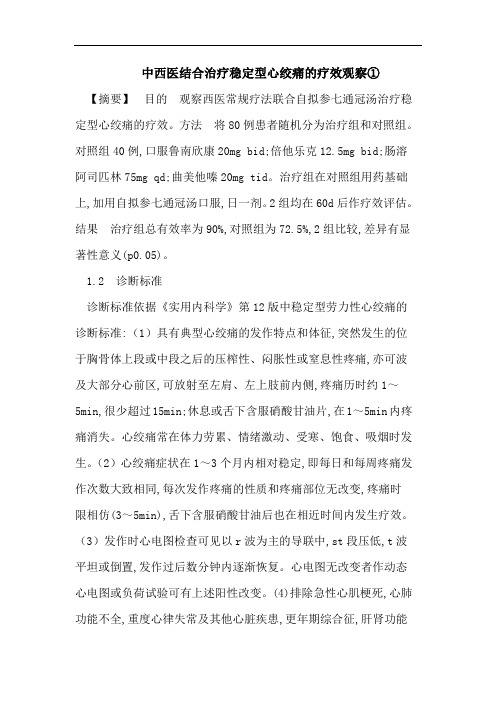
中西医结合治疗稳定型心绞痛的疗效观察①【摘要】目的观察西医常规疗法联合自拟参七通冠汤治疗稳定型心绞痛的疗效。
方法将80例患者随机分为治疗组和对照组。
对照组40例,口服鲁南欣康20mg bid;倍他乐克12.5mg bid;肠溶阿司匹林75mg qd;曲美他嗪20mg tid。
治疗组在对照组用药基础上,加用自拟参七通冠汤口服,日一剂。
2组均在60d后作疗效评估。
结果治疗组总有效率为90%,对照组为72.5%,2组比较,差异有显著性意义(p0.05)。
1.2 诊断标准诊断标准依据《实用内科学》第12版中稳定型劳力性心绞痛的诊断标准:(1)具有典型心绞痛的发作特点和体征,突然发生的位于胸骨体上段或中段之后的压榨性、闷胀性或窒息性疼痛,亦可波及大部分心前区,可放射至左肩、左上肢前内侧,疼痛历时约1~5min,很少超过15min;休息或舌下含服硝酸甘油片,在1~5min内疼痛消失。
心绞痛常在体力劳累、情绪激动、受寒、饱食、吸烟时发生。
(2)心绞痛症状在1~3个月内相对稳定,即每日和每周疼痛发作次数大致相同,每次发作疼痛的性质和疼痛部位无改变,疼痛时限相仿(3~5min),舌下含服硝酸甘油后也在相近时间内发生疗效。
(3)发作时心电图检查可见以r波为主的导联中,st段压低,t波平坦或倒置,发作过后数分钟内逐渐恢复。
心电图无改变者作动态心电图或负荷试验可有上述阳性改变。
(4)排除急性心肌梗死,心肺功能不全,重度心律失常及其他心脏疾患,更年期综合征,肝肾功能损害及其他系统严重原发性疾病者[2]。
2 治疗方法2.1 对照组口服鲁南欣康20mg bid;倍他乐克12.5mg bid;肠溶阿司匹林75mg qd;曲美他嗪20mg tid。
心绞痛急性发作时舌下含服硝酸甘油0.3mg。
合并高血压、糖尿病、高脂血症者配合降血压、降血糖及降血脂治疗。
2.2 治疗组在对照组西药治疗的基础上,以自拟参七通冠汤为基础方。
方药组成:西洋参5g(另炖)、田七5g(另炖)、麦冬10g、五味子8g、茯苓10g、桂枝6g、白术10g、炙甘草6g、瓜蒌皮15g、薤白10g、法夏8g、红花6g、丹参15g、山楂10g、香附10g。
稳定型心绞痛的中医辨证施护体会论文

稳定型心绞痛的中医辨证施护体会【中图分类号】r473 【文献标识码】a 【文章编号】1004-7484(2012)11-0505-01稳定型心绞痛是冠状动脉粥样硬化性心脏病的一种,随着社会的进步和人民生活水平的提高,其发病率逐年上升,已成为严重危害人类健康的疾病之一。
稳定型心绞痛属于中医“胸痹”、“心痛”范畴,临床上为心血瘀阻、气滞血瘀、痰浊痹阻、寒凝心脉、气阴两虚、心肾阳虚等证型。
近年来,塘县人民医院中西医结合科采用中医辨证治疗和辨证施护相结合的方法治疗冠心病心绞痛,取得了较好的疗效,现报道如下:1 辨证施护1.1 饮食调护:宜进低盐、低脂、低热量、高维生素、高纤维的饮食,多食水果、蔬菜,保持大便通畅。
中医辨证属心血瘀阻、气滞血瘀者饮食宜清淡、易消化,以低盐、低脂、营养丰富之品为原则,忌食肥甘厚味和辛辣刺激之品,可食薤白粥、桃仁粥,以行气开郁,并少吃多餐。
特别是晚餐不可过饱,适当多食水果和蔬菜,保持大便通畅,平素养成定时排便的良好习惯。
痰浊痹阻者不易过食肥甘滋腻食物,可进萝卜粥,薏苡仁粥以起到化痰开窍之功。
做到定时、定量、少量多餐,以免损伤脾胃,助湿生痰加速病情发展。
平时可食萝卜、橘子、丝瓜、绿豆。
肥胖者酌情控制饮食量,以减轻体质量,减少痰浊内生。
寒凝心脉者饮食以温阳散寒为原则,禁食生冷瓜果等寒凉之品,宜吃温热食物,或饮用少量米酒,可用干姜、川椒等调味,以温阳散寒。
气血两虚者饮食宜予补气养阴之品,如红枣、桂圆、瘦肉、莲子、蛋类、牛乳、鱼肉,适当配合益气养阴的中药如山药、黄芪、百合熬粥以调补。
心肾痰浊痹阻寒凝心脉心肾阳虚气阴两虚心血瘀阻、气滞血瘀发病初期要绝对卧床休息,谢绝探视,保证充足睡眠,以减少气血的耗伤,酌情逐渐增加活动量,以利气血通畅。
针对患者具体情况做好心理护理,通过卫生宣教使患者心情舒畅,积极配合治疗,尤其对年老患者应注意态度和蔼,耐心解释,解除忧虑和恐惧心理。
因胸痛入夜更甚,应加强夜间巡视观察,发现患者胸痛剧烈、冷汗出、气短、唇紫、肢凉等症状时,应速告知医生和做好抢救准备,并配合医生做好相应的治疗和护理。
稳定型心绞痛诊疗规范

稳定型心绞痛心绞痛是冠状动脉供血不足,心肌急剧的、暂时的缺血与缺氧所引起的临床综合征。
当冠状动脉供血与心肌的需要之间发生矛盾,冠状动脉血流量不能满足心肌代谢的需要,可引起心肌缺血缺氧,并伴有代谢产物的堆积 (乳酸、丙酮酸、磷酸等)刺激神经发生疼痛,缺血时伴有心脏收缩功能的障碍出现憋气等症状,同时会导致心脏电活动不稳定发生心律失常。
一部分病人由于病变炎症活动加居导致斑块破裂继发血栓形成不稳定心绞痛或心肌梗死。
【临床表现】稳定型心绞痛以发作性胸痛为主要临床表现,疼痛的特点:1.部位:主要在胸骨体上段或中段之间可波及心前区,有手掌大小范围,甚至横贯前胸,界限不很清楚。
常放射至左肩、左臂内侧达无名指和小指,或至颈、咽或下颌部。
2.性质:常为紧缩感、绞榨感、压迫感、胸闷等。
也可有烧灼感但不尖锐,不像针刺和刀扎,偶伴濒死的恐惧感觉,病人不自觉停止原来活动。
3.持续时间:一般2~5分钟,一般不超过10分钟。
4.诱因:发作常由体力劳动或情绪激动所激发,饱食、寒冷、吸烟、心动过速、休克等亦可诱发。
舌下含化硝酸甘油片可在2~5分钟内缓解。
【诊断要点】1.病史询问,有或无上述表现;2.体格检查,平时一般无异常体征。
心绞痛发作时常见心率增快、血压升高、表情焦虑、皮肤冷或出汗,有时出现第四或第三心音奔马律。
可有暂时性心尖部收缩期杂音,多为乳头肌缺血功能失调引起二尖瓣关闭不全所致,第二心音可有逆分裂或出现交替脉;3.实验室检查了解冠心病危险因素:空腹血糖、血脂检查,必要时查糖耐量。
了解贫血、甲状腺功能。
胸痛明显者,查血肌钙蛋白、肌酸激酶;4.心电图:(1)静息心电图:静息心电图多正常,静息心电图可表现出冠心病的迹象,如陈旧性心肌梗死或异常复极。
(2)发作时的心电图:大多数病人相邻的二个导联ST段压低(水平型或下斜型),发作时记录的心电图正常也并不罕见,不应该排除心肌缺血诊断。
胸痛同时出现快速性心律失常(早搏或心动过速)、房室传导阻滞、左前分支阻滞或束支传导阻滞。
冠心病稳定型心绞痛中医诊疗指引-中华中医药学会
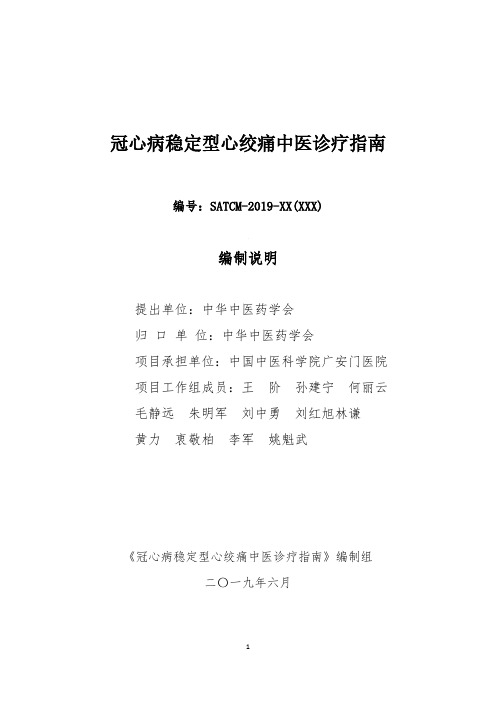
冠心病稳定型心绞痛中医诊疗指南编号:SATCM-2019-XX(XXX)编制说明提出单位:中华中医药学会归口单位:中华中医药学会项目承担单位:中国中医科学院广安门医院项目工作组成员:王阶孙建宁何丽云毛静远朱明军刘中勇刘红旭林谦黄力衷敬柏李军姚魁武《冠心病稳定型心绞痛中医诊疗指南》编制组二〇一九年六月目录一、背景介绍 (4)(一)任务背景 (4)(二)任务参加单位 (4)二、专家委员会及工作组 (4)(一)指南指导委员会 (5)(二)方法学专家 (5)(三)疾病领域专家委员会 (5)(四)主要起草人 (5)(五)系统评价组 (6)(六)秘书处 (6)三、主要工作过程 (6)(一)启动 (6)(二)起草 (7)1.组织管理 (7)2.利益冲突声明 (7)3.定义临床问题 (7)4.确定临床问题清单 (7)5.收集证据与系统评价 (8)6.证据质量评价 (9)7.形成推荐意见 (9)8.指导委员会修改 (9)9.指南质量评价 (10)(三)征求意见 (10)四、技术内容的确认方法与依据 (10)(一)总体内容 (10)(二)内容分解 (10)五、与相关法律、法规和强制性标准的关系 (10)六、重大分期意见的处理经过和依据 (10)七、作为推荐性标准的建议 (10)八、贯彻标准的要求和措施建议 (10)九、指南更新计划 (11)十、附件 (11)一、背景介绍(一)任务背景冠心病(coronary atherosclerotic heart disease, CAHD)是指由于冠状动脉粥样硬化使管腔狭窄或阻塞导致心肌缺血、缺氧而引发的心脏病,是动脉粥样硬化导致器官病变的最常见类型。
1979年世界卫生组织将其分为心绞痛、无症状性心肌缺血、心肌梗死、猝死、缺血性心肌病。
心绞痛是指冠状动脉供血不足,心肌急剧的、暂时的缺血与缺氧所引起的临床综合征。
其中,稳定型心绞痛(stable angina pectoris, SAP)最为常见,其发作程度、发作频率、性质及诱发因素在1-3个月内无明显变化。
中西医结合治疗冠心病稳定型心绞痛气虚血瘀证临床观察

参考文献 : [1]帅 昌伟 .中西医结合治疗 肾病综合 征 3O例临床 观察与分 析[J].
当代 医学 ,2013,19(33):155. [2]王港 .中西医结合治疗 肾病综合征的疗效 观察 [J].湖南中医药 大
作者简介 :张 占峰 (1977一),男 ,硕士,副主任医师 ,研究方 向:中西医结合防治心血管疾病。
中西 医治疗 的观察 组患者 ,其治疗总有效 率 以及 Vmin、Vmax、 RI等 肾脏血 流参数 改善 情况 均显 著优 于单 纯应 用 西医治 疗 的对照组 (P<0.05)。这一 结果 进一 步证 实 了对 于 Ns患 者 而言 ,中西医结合治疗有着单纯西医治疗不可 比拟 的优势 。
关键 词 :冠心病 ;心 绞痛 ;气虚血瘀证 ;中西 医结合 中图分类号 :R256.22 文献标志码 :B 文章编号 :1007—2349(2018)02—0029一o2
冠心病稳 定型心 绞痛是 常见 的冠心 病类 型 ,中老 年人是 主要发 病群 体 ,且 近年来 发 病率有 所 提升 ,严 重危 害生 命健 康 。虽然 目前针对 高危因素 进行 干预 和二级 预 防,但 发病具 有 隐匿性 ,猝死率高 ,因此临床治疗效果不 如人意 ‘】 。随着 中 医研究 的深入 ,实践 证实 中药 治疗该疾 病具 有较 高的应 用 价 值 ,成为临床 医师 的研究重点 。笔 者对本 院 82例气虚 血瘀证 患者进 行研 究 ,探讨 了中西 医结合 治 疗 的临床 效果 ,现报道 如 下 。 1 资料与 方法 1.1 临床资料 选取本 院于 2013年 6月—2016年 l2月 收 治的冠心病稳 定型心绞痛气虚血 瘀证病例 82例 。将 82例患 者分 成 2组 :对 照组 4l例 ,包 括男 18例 (43.9% ),女 23例 (56.1% );年龄位 于44—68岁 ,平均 (58.4±6.7)岁 ;病程 2~ 8 a,平均 (3.5±1.6)a。观察组 41例 ,包 括男 21例(51.2%), 女 20例 (48.8%);年龄位 于 45—70岁 ,平均 (60.5±6.3)岁 ; 病程 2—7 a,平均 (3.3±1.4)a。2组性 别 、年龄 、病程 无明显 差异 (P>0.05),具有可 比性。 1.2 纳入 和排 除标 准 依 据《缺血性心脏 病的命名及 诊断标
中医临床路径在稳定型心绞痛诊疗中的应用研究

( 长春 中 医药大学 附属 医院 , 吉林 长春 1 3 0 0 2 1 )
中 图分 类 号 : R 5 4 1 . 4 文献 标 志 码 : A 文章编号 : 1 0 0 4 — 7 4 5 X( 2 0 1 4 ) 0 3 — 0 4 2 6 — 0 3
d o i : 1 0 . 3 9 6 9  ̄ . i s s n . 1 0 0 4 - 7 4 5 X . 2 0 1 4 . 0 3 . 0 1 9 【 摘要 】目的 观察 中医临床路径在冠心病稳定型心绞痛诊疗 中的疗效及优势 。方法 7 2例冠心病稳定型心
w a y g r o u p . I n d i c e s w e r e o b s e r v e d i n c l u d i n g t h e t o t l a me d i c a l c o s t s , t h e l e n g t h o f h o s p i t l a s t a y , t h e c u r a t i v e e fe c t o f
一
4 2 6一
中 国 中 医急 症 2 0 1 4年 3月 第 2 3卷第 3期 J E T C M. Ma r . 2 0 1 4, V o 1 . 2 3, N o . 3
・
研 究 报 告 ・
中医 临床 路径 在稳 定 型 心绞 痛诊 疗 中的应用 研究 术
靳宏 光 王 义强 姜 丽红
t h e a n in g a p e c t o r i s , t h e c u r a t i v e e f e c t o f t h e e l e c t r o c a r d i o r g a m a n d t h e S A Q s c o r e s . R e s u l t s : I n c o n t r a c t w i t h t h e
中西医结合治疗稳定型心绞痛的疗效观察
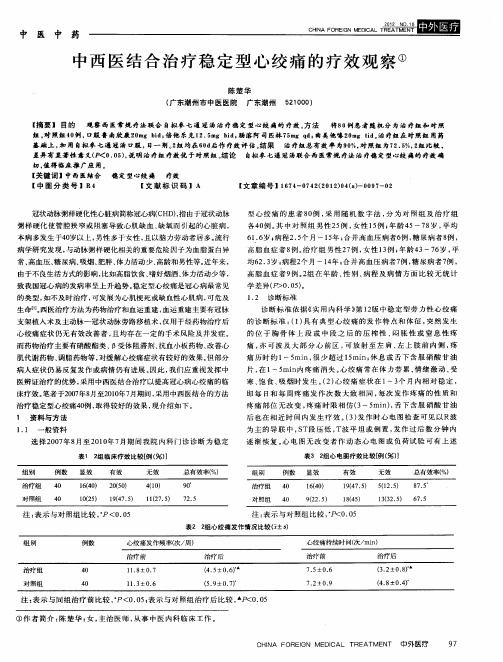
【 关键 词 】中西 医结合 稳 定 型心绞 痛 疗效
【 图 分 类 号 lR4 中
【 献 标 识 码 】A 文
【 章 编 号 】1 7 -0 4 (0 0 () 0 7 0 文 4 7 22 1 )4a-0 9 - 2 6 2
冠状 动脉 粥样 硬化 性心脏 病 简称冠 心病( H )指 由于冠状 动脉 C D, 粥样 硬 化 使 管腔 狭 窄 或 阻 塞导 致 心 肌 缺血 、 氧 而 引起 的心 脏 病 , 缺
6 . 岁 ; 程 2 5 月 ~1 年 ; 并 高血 压 病 者 6 , 尿 病者 8 , 16 病 .个 5 合 例 糖 例
病 学研 究发 现 , 与动 脉 粥样 硬 化相 关 的重 要危 险 因子 为血 脂 蛋 白异 常、 高血 压 、 尿病 、 糖 吸烟 、 肥胖 、 力活 动少 、 体 高龄 和 男性等 。 年来 , 近 由于不 良生 活 方式 的影 响 , 比如 高 脂饮 食、 嗜好 烟酒 、 力活 动少 等 , 体 致 我 国冠 心病 的 发病 率 呈上 升 趋 势。 定 型心 绞 痛是 冠心 病 最 常见 稳
本 病 多发 生 于4 岁以 上 , 0 男性 多于 女性 , 且以 脑 力劳 动者 居 多 。 流行
型 心 绞 痛 的 患 者 8 例 , 用 随 机 数 字 法 , 为 对 照 组 及 治 疗 组 0 采 分
各4 例 。 中 对 照组 男 性 2 例 , 性 1 例 ; 龄 4 ~7 岁 , 均 0 其 5 女 5 年 5 8 平
治 疗 稳 定 型心 绞痛 4 例 , 得较 好 的效 果 , 介 绍如 下 。 0 取 现
疼 痛 部 位 无 改 变 , 痛 Байду номын сангаас 限 相 仿 ( ~5 n , 下 含 服 硝 酸 甘 油 疼 3 mi )舌 后 也 在 相 近 时 间内 发 生 疗 效 。 3 发 作 时 心 电 图 检 查 可 见 以 R波 ()
《柴胡疏肝散加味治疗稳定型心绞痛(气滞血瘀证)伴焦虑状态的临床疗效观察》
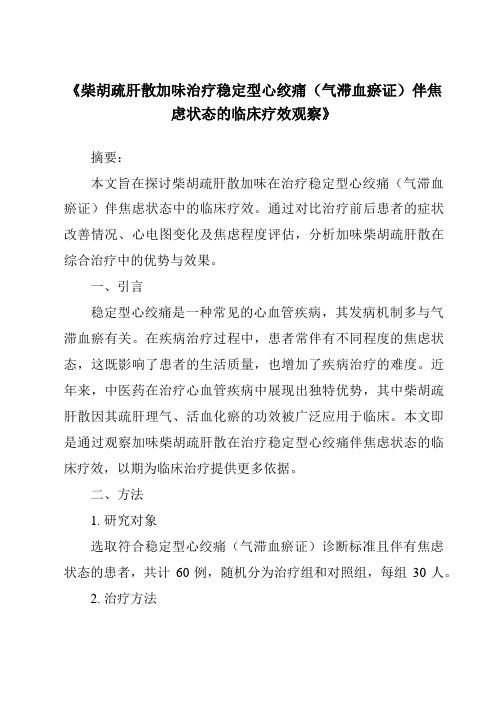
《柴胡疏肝散加味治疗稳定型心绞痛(气滞血瘀证)伴焦虑状态的临床疗效观察》摘要:本文旨在探讨柴胡疏肝散加味在治疗稳定型心绞痛(气滞血瘀证)伴焦虑状态中的临床疗效。
通过对比治疗前后患者的症状改善情况、心电图变化及焦虑程度评估,分析加味柴胡疏肝散在综合治疗中的优势与效果。
一、引言稳定型心绞痛是一种常见的心血管疾病,其发病机制多与气滞血瘀有关。
在疾病治疗过程中,患者常伴有不同程度的焦虑状态,这既影响了患者的生活质量,也增加了疾病治疗的难度。
近年来,中医药在治疗心血管疾病中展现出独特优势,其中柴胡疏肝散因其疏肝理气、活血化瘀的功效被广泛应用于临床。
本文即是通过观察加味柴胡疏肝散在治疗稳定型心绞痛伴焦虑状态的临床疗效,以期为临床治疗提供更多依据。
二、方法1. 研究对象选取符合稳定型心绞痛(气滞血瘀证)诊断标准且伴有焦虑状态的患者,共计60例,随机分为治疗组和对照组,每组30人。
2. 治疗方法对照组采用常规西药治疗,包括硝酸酯类药物、抗凝药物及降脂药物等。
治疗组在常规治疗基础上加用柴胡疏肝散加味,根据患者具体情况进行个体化加减。
3. 观察指标(1)症状改善情况:包括心绞痛发作频率、程度及持续时间;(2)心电图变化;(3)焦虑程度评估:采用焦虑自评量表(SAS)进行评估;(4)不良反应及药物耐受情况。
三、结果1. 症状改善情况经过一个疗程的治疗(4周),治疗组在心绞痛发作频率、程度及持续时间方面均有显著改善,与对照组相比,差异具有统计学意义。
2. 心电图变化治疗组心电图ST-T段改善程度较对照组更为明显,心肌缺血改善情况优于对照组。
3. 焦虑程度评估治疗组患者在治疗后SAS评分较治疗前明显降低,且降低幅度大于对照组,表明加用柴胡疏肝散加味能够更好地改善患者的焦虑状态。
4. 不良反应及药物耐受情况两组患者在治疗过程中均未出现严重不良反应,药物耐受情况良好。
四、讨论稳定型心绞痛伴焦虑状态的治疗,既要关注心血管疾病的本身治疗,也要重视患者的心理调适。
穴位注射联合血府逐瘀汤治疗心脉瘀阻型稳定型心绞痛临床疗效观察
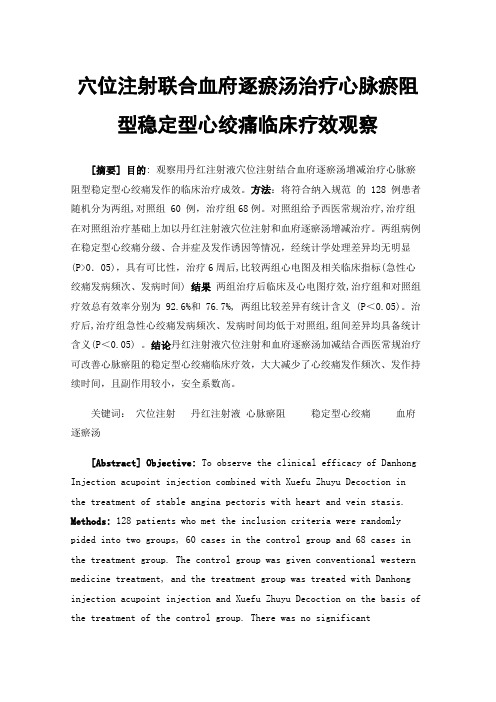
穴位注射联合血府逐瘀汤治疗心脉瘀阻型稳定型心绞痛临床疗效观察[摘要]目的: 观察用丹红注射液穴位注射结合血府逐瘀汤增减治疗心脉瘀阻型稳定型心绞痛发作的临床治疗成效。
方法:将符合纳入规范的 128 例患者随机分为两组,对照组 60 例,治疗组68例。
对照组给予西医常规治疗,治疗组在对照组治疗基础上加以丹红注射液穴位注射和血府逐瘀汤增减治疗。
两组病例在稳定型心绞痛分级、合并症及发作诱因等情况,经统计学处理差异均无明显(P>0.05),具有可比性,治疗6周后,比较两组心电图及相关临床指标(急性心绞痛发病频次、发病时间) 结果两组治疗后临床及心电图疗效,治疗组和对照组疗效总有效率分别为 92.6%和 76.7%, 两组比较差异有统计含义 (P<0.05)。
治疗后,治疗组急性心绞痛发病频次、发病时间均低于对照组,组间差异均具备统计含义(P<0.05) 。
结论丹红注射液穴位注射和血府逐瘀汤加减结合西医常规治疗可改善心脉瘀阻的稳定型心绞痛临床疗效,大大减少了心绞痛发作频次、发作持续时间,且副作用较小,安全系数高。
关键词:穴位注射丹红注射液心脉瘀阻稳定型心绞痛血府逐瘀汤[Abstract] Objective: To observe the clinical efficacy of Danhong Injection acupoint injection combined with Xuefu Zhuyu Decoction in the treatment of stable angina pectoris with heart and vein stasis. Methods: 128 patients who met the inclusion criteria were randomly pided into two groups, 60 cases in the control group and 68 cases in the treatment group. The control group was given conventional western medicine treatment, and the treatment group was treated with Danhong injection acupoint injection and Xuefu Zhuyu Decoction on the basis of the treatment of the control group. There was no significantdifference in the classification of stable angina pectoris, complications and attack inducements between the two groups (P> 0.05), indicating comparability. After 6 weeks of treatment, ecg and related clinical indicators (angina attack frequency, attack duration) were compared between the two groups. Results The clinical and ECG efficacy of the two groups after treatment, the total effective rate of the treatment group and the control group were 92.6% and 76.7%, respectively, and the difference between the two groups wasstatistically significant (P < 0.05). After treatment, the attack frequency and duration of angina pectoris in the treatment group were better than those in the control group, with statistical significance (P < 0.05). Conclusion Danhong injection acupoint injection and Xuefu Zhuyu Decoction combined with conventional treatment of Western medicine can improve the clinical efficacy of stable angina pectoris, reduce the frequency and duration of angina pectoris, with small side effects and high safety. .冠状动脉粥样硬化心血管疾病的突发是由于冠状动脉毛细血管形成粥样硬化病灶,而形成血管管腔狭小或阻塞,所形成的心脏缺氧、低氧、严重形成坏死所引发的心血管疾病,稳定型急性心绞痛是主要临床表现之一[1)。
四逆散合瓜蒌薤白半夏汤加减治疗稳定型心绞痛(气滞痰阻型)的疗效探究演示稿件

1. 提供新的治疗思路:四逆散合瓜蒌薤白半夏汤加减 为气滞痰阻型稳定型心绞痛的治疗提供了新的思路和方 法。
启示
2. 推广临床应用:在确保安全性和有效性的前提下, 应进一步推广该治疗方法在临床上的应用,为更多患者 带来福音。
对未来研究的建议与展望
在此添加您的文本17字
建议
在此添加您的文本16字
1. 加强长期追踪研究:未来研究应加强对患者的长期追 踪,以全面评估四逆散合瓜蒌薤白半夏汤加减治疗的远期 效果和安全性。
3
温阳通脉
瓜蒌薤白半夏汤中的一些药物成分具有温阳通脉 的作用,能够促进血液循环,缓解肢体冷痛等症 状。
两方合用的药理作用
协同增效
四逆散与瓜蒌薤白半夏汤合用,能够产生协同作用,增强药效,更 好地缓解稳定型心绞痛(气滞痰阻型)的症状。
全面调理
两方合用可以综合调理气机、活血化瘀、清热利湿、宽胸散结、化 痰止咳和温阳通脉等方面,从而全面改善患者的病情。
四逆散合瓜蒌薤白 半夏汤加减治疗稳 定型心绞痛(气滞 痰阻型)的疗效探 究
目录
• 引言 • 稳定型心绞痛(气滞痰阻型)概述 • 四逆散合瓜蒌薤白半夏汤的药理作用 • 研究方法与实验设计 • 实验结果与分析 • 讨论与结论
01
CATALOGUE
引言
研究背景
稳定型心绞痛是冠心病的一种常见类型,其病理机制复杂,涉及多种因素,如冠状动脉粥样硬化、炎 症反应等。
患者生活质量评估
要点一
生活质量改善
治疗后,患者心绞痛发作频率减少,持续时间缩短,生活 质量得到明显改善。
要点二
心理状态改善
患者焦虑、抑郁等心理状态也得到一定程度的缓解,有助 于提高患者的生活质量。
06
稳定型心绞痛

稳定型心绞痛亦称劳力性心绞痛,是在冠状动脉狭窄的基础上,由于心肌负荷的增加而引起心肌急剧的、暂时的缺血与缺氧的临床综合征。
本病的临床重要特征是在数周至数月内,疼痛发作的程度、频率、性质和诱因无明显变化。
【病因与发病机制】本病的基本病因是冠状动脉粥样硬化。
正常情况下,冠状循环血流量具有很大的储备力量, 其血流量可随身体的生理情况有显著的变化。
机体在剧烈体力活动、情绪激动等对氧的需求增加时,冠状动脉适当扩张,血流量增加(可增加6〜7倍),达到供求平衡。
当冠状动脉粥样硬化致冠状动脉狭窄或部分分支闭塞时,其扩张性减弱,血流量减少,当心肌的血供减少到尚能应付平时的需要,则休息时无症状。
一旦心脏负荷突然增加,如劳累、激动、心力衰竭、饱餐、寒冷等情况下使心脏负荷增加,心肌耗氧量增加时,对血液的需求增加,而冠状动脉的供血已不能相应增加,即可引起心绞痛。
产生疼痛感觉的直接因素,可能是在缺血缺氧的情况下,心肌内积聚过多的代谢产物,如乳酸、丙酮酸、磷酸等酸性物质,或类似激肽的多肽类物质,刺激心脏内自主神经的传入纤维末梢,经胸交感神经节和相应的脊髓段,传至大脑,产生疼痛感觉。
这种痛觉反映在与自主神经进入水平相同脊髓段的脊神经所分布的区域,即胸骨后及两臂的前内侧与小指,尤其是在左侧,产生相应部位放射痛。
【临床表现】1.症状以发作性胸痛为主要临床表现,典型疼痛的特点为:(1)部位:主要在胸骨体中、上段之后,或心前区,界限不很清楚,常放射至左肩、左臂内侧达无名指和小指,或至颈、咽或下颌部。
(2)性质:常为压迫样、憋闷感或紧缩样感,也可有烧灼感,但与针刺或刀割样锐性痛不同,偶伴濒死感。
有些病人仅觉胸闷而非胸痛。
发作时,病人往往不自觉地停止原来的活动,直至症状缓解。
(3)诱因:体力劳动、情绪激动、饱餐、寒冷、吸烟、心动过速、休克等。
其疼痛的发生往往是在劳力或情绪激动的当时,而不是在其之后。
(4)持续时间:疼痛出现后常逐渐加重,持续3〜5分钟,一般休息或舌下含服硝酸甘油可缓解。
胸痹心痛病慢性稳定型心绞痛基层中西医结合诊疗方案

胸痹心痛病(慢性稳定型心绞痛)基层中西医结合诊疗方案一、诊断(一)疾病诊断1、中医诊断:参照《中医内科常见病诊疗指南中医病证部分》(ZYYXH/T4~ 49──2008)。
以心前区疼痛、憋闷、短气为主症。
表现为胸骨后或胸膺部发作性疼痛,常为绞痛、刺痛或隐痛;疼痛可放射于左肩背、左臂内侧、颈、咽喉等部位,时作时止,反复发作;疼痛一般持续数十秒至十余分钟,一般不超过30分钟,休息或服药后可缓解。
多伴有心悸怔忡、短气乏力、呼吸不畅,甚则喘促、面色苍白、自汗等。
临床以气虚、阳虚、阴虚、血瘀、气滞、痰浊的病机为多,可见相应的舌象、脉象。
2、西医诊断:参照2007年中华医学会心血管病学分会、中华医学会心血管杂志编辑委员会发布的《慢性稳定性心绞痛诊断与治疗指南》。
根据胸痛患者的年龄、性别、心血管危险因素、疼痛的特点来估计冠心病的可能性,并依据病史、体格检查、相关的无创检查及有创检查结果作出诊断及分层危险的评价。
3、心绞痛分级标准:参照1972年加拿大心血管学会心绞痛严重分级标准。
Ⅰ级:一般体力活动不引起心绞痛,例如行走和上楼,但紧张、快速或持续用力可引起心绞痛的发作;Ⅱ级:日常体力活动稍受限制,快步行走或上楼、登高、饭后行走或上楼、寒冷或风中行走、情绪激动可发作心绞痛或仅在睡醒后数小时内发作。
在正常情况下以一般速度平地步行200m以上或登一层以上的楼梯受限。
Ⅲ级:日常体力活动明显限制,在正常情况下以一般速度平地步行100-200m 或登一层楼梯时可发作心绞痛;Ⅳ级:轻微活动或休息时即可以出现心绞痛症状。
(二)证侯诊断1、心痛发作期(1)寒凝血瘀证:遇冷则疼痛发作,或闷痛,舌淡暗、苔白腻,脉滑涩。
(2)气滞血瘀证:疼痛剧烈多与情绪因素有关,舌暗或紫暗、苔白,脉弦滑。
2、心痛缓解期(1)气虚血瘀证:胸痛、胸闷,动则尤甚,休息时减轻,乏力气短,心悸汗出,舌体胖有齿痕,舌质暗有瘀斑或瘀点、苔薄白,脉弦或有间歇。
(2)气阴两虚、心血瘀阻证:胸闷隐痛、时作时止,心悸气短,倦怠懒言,面色少华,头晕目眩,遇劳则甚,舌暗红少津,脉细弱或结代。
- 1、下载文档前请自行甄别文档内容的完整性,平台不提供额外的编辑、内容补充、找答案等附加服务。
- 2、"仅部分预览"的文档,不可在线预览部分如存在完整性等问题,可反馈申请退款(可完整预览的文档不适用该条件!)。
- 3、如文档侵犯您的权益,请联系客服反馈,我们会尽快为您处理(人工客服工作时间:9:00-18:30)。
Traditional Chinese Medicine 中医学, 2019, 8(1), 35-41Published Online January 2019 in Hans. /journal/tcmhttps:///10.12677/tcm.2019.81008Traditional Chinese Medicine SyndromeType Analysis of Stable Angina PectorisYiru Wang1,2, Ping Liu1,21Longhua Hospital Affiliated to Shanghai University of Traditional Chinese Medicine, Shanghai2Shanghai University of Traditional Chinese Medicine, ShanghaiReceived: Dec. 26th, 2018; accepted: Jan. 4th, 2019; published: Jan. 11th, 2019AbstractObjective: To explore the inherent law and frequency of Traditional Chinese Medicine (TCM) syn-drome types of stable angina pectoris (SAP), and deepen the current understanding of different TCM types of SAP, to guide the clinical medication. Methods: Literature reports related to TCM syndrome classification of SAP were collected since 1979 according to inclusion and exclusion criteria. Frequencie method and chi-square test were applied to analyse data. Results: 34 articles were included. The analysis results indicated 10 most common kinds of SAP patterns: qi deficiency and blood stasis, heart blood stasis, phlegm and blood stasis, phlegm in heart vessels, qi and blood stasis, qi deficiency with blood stasis and phlegm, qi and yin deficiency, qi deficiency with phlegm, cold in heart vessels, weak heart yang. Excess syndrome is most common, especially heart blood stasis and phlegm and blood stasis. The second one is syndrome of intermingled deficiency and excess. Based on qi deficiency, it is accompanied by blood stasis, phlegm and blood stasis or phlegm stasis. Conclusions: At present, the research on TCM syndrome types of SAP is still at the exploratory stage, and large sample TCM syndrome investigation is still needed to improve the re-liability and scientificity.KeywordsStable Angina Pectoris, Analysis of Syndrome, Traditional Chinese Medicine稳定型心绞痛的中医证型分析王怡茹1,2,刘萍1,21上海中医药大学附属龙华医院,上海2上海中医药大学,上海收稿日期:2018年12月26日;录用日期:2019年1月4日;发布日期:2019年1月11日王怡茹,刘萍摘要目的:探讨稳定型心绞痛中医证型的出现频率以及其内在规律,加深目前中医对稳定型心绞痛不同证型的认识,以期一定程度上指导临床用药。
方法:收集自1979年起我国与稳定型心绞痛中医证型分型有关的文献报道,按照一定的纳排标准,对纳入文献中的病例资料数据进行提取,应用Frequencie 法和卡方检验进行数据处理。
结果:共纳入34篇论文,分析结果显示稳定型心绞痛常见证型有10种,分别为气虚血瘀、心血瘀阻、痰瘀交阻、痰阻心脉、气滞血瘀、气虚兼痰瘀交阻、气阴两虚、气虚痰阻、寒凝心脉、心阳不振。
稳定型心绞痛证型以实证多见,其中心血瘀阻和痰瘀交阻是最常见的证型。
其次是虚实夹杂证,其中多以气虚为本,在此基础上伴有血瘀、痰瘀交阻、痰阻等标实表现。
结论:目前对稳定型心绞痛中医证候的证型研究尚属于探索阶段,仍需展开大样本的中医证候调查以提高证据的可靠性与科学性。
关键词稳定型心绞痛,证型分析,中医Copyright © 2019 by author(s) and Hans Publishers Inc.This work is licensed under the Creative Commons Attribution International License (CC BY). /licenses/by/4.0/1. 引言稳定型心绞痛是冠心病的一种分型,指多种原因造成冠状动脉狭窄,心肌暂时性缺血缺氧而产生的一系列临床症状,治疗不及时则发生急性心肌梗死,猝死率极高。
2009年的一份流调中提示急性心血管事件是全球人口排名第一的致死原因[1],我国最新的流调中显示,冠心病死亡占居民疾病死亡构成40%以上,居首位,高于肿瘤及其他疾病[2]。
近几年采用中药治疗稳定型心绞痛的研究日趋增多,不乏一些系统评价提示中药疗效尚可[3],另外采用中西医结合的方法更是可有效预防冠心病急性心血管事件的二次复发[4]。
但患者临床症状复杂,证型不一,为了探讨稳定型心绞痛中医证型出现的频率及内在关系,明确临床常见的中医证型,使中医药治疗更具针对性,本文就相关文献进行了纳排、整理、数据提取和统计分析。
2. 资料收集2.1. 资料检索采用电子数据库检索与人工检索相结合的方法,检索1979~2018年间公开发表在国内医学期刊上关于中医药及中西医结合治疗稳定型心绞痛的文献,首次检索词为“冠心病”和“稳定型心绞痛”,二次检索词为“辩证”、“分型”、“证型”、“中医”和“中西医”。
2.2. 文献纳入和排除标准纳入标准:1) 符合稳定型心绞痛的诊断标准;2) 有明确的中医辩证分型;3) 文献类型为临床研究。
排除标准:1) 重复发表的文献,或相同临床资料多次发表;2) 资料来源不明确,与临床实际情况明显不符;3) 只记录自拟方名,无具体辨证和治则的;4) 动物实验、综述、评论或方法学等。
王怡茹,刘萍2.3. 中医证名辩证分型的规范参考标准为《中医诊断学》[4]第五版教材的中医基本证候描述。
2.4. 文献整理通过首次和二次检索,共检索到1972年以来国内公开发表的稳定型心绞痛的中医文献共137篇,按文献入和排除标准共筛选出符合要求的文献42篇,收集到病例2508例。
2.5. 证型归纳方法42篇文献中稳定型心绞痛证型分类数目不一,最少的分1型,最多者可达9型,涉及不同名称的中医证型多达33种,将这33种证型按异名同类及主证、次证、苔、脉的描述进行分类归纳。
具体实施如下:1) 笼统的辩证分型如实证、虚证、热证、寒证等删除。
2) 不同说法但实质相同归为同一证型:如心血瘀阻、瘀血阻络、瘀结于内、瘀阻血脉等统一归为心血瘀阻;痰阻心脉、痰浊壅塞、痰浊阻闭等统一归为痰阻心脉。
3) 不同证型根据所述的主症及病因病机,实质相同或相似者归为一证,如痰阻心脉、痰热阻络、痰气互结,都是由于痰湿凝滞,化热或阻滞气机,因此均归为痰阻心脉。
4) 根据文献中的治法和方剂,转换成与其对应的证型,如补益肝肾法转换成肝肾不足证,活血化瘀法转换成心血瘀阻证。
最终总结出15个证型,其中各个证型及其在42篇文献中提到的频次如表1所示。
3. 统计学分析采用SPSS25.0软件,数据采用Frequencie法和χ2检验进行分析,明确其统计学意义。
数据的提取及录入由两名提前接受过培训的人员独立完成,若有不同二者通过查阅原始文献和讨论的方法决定最终结果。
4. 统计结果4.1. 证型频次分布情况(见表1)根据表1频次多少将其划为常见证型与少见证型两大类,可认为常见证型有10种,分别为气虚血瘀、心血瘀阻、痰瘀交阻、痰阻心脉、气滞血瘀、气虚兼痰瘀交阻、气阴两虚、气虚痰阻、寒凝心脉、心阳不振;少见证型有5种,分别为阳虚兼气滞血瘀、心肾阳虚、阳虚寒凝、阳虚兼痰瘀交阻、气阴两虚兼痰瘀闭塞。
其中气虚血瘀所占比例最高,共计31篇文献,占25.76%;其次是心血瘀阻,共22篇文献,占13.28%;排在第三位的是痰阻心脉,共计18篇文献,占10.93%。
Table 1. The literature of TCM syndrome type of frequency distribution table of 42 studies表1. 42篇文献中医证型频次分布表实证虚实夹杂虚证证型频次比例(%) 证型频次比例(%) 证型频次比例(%) 心血瘀阻333 13.28 气虚血瘀646 25.76 气阴两虚147 5.86 痰瘀交阻274 10.93 气虚兼痰瘀交阻164 6.54 心阳不振98 3.91 痰阻心脉240 9.57 气虚痰阻102 4.07 心肾阳虚42 1.67 气滞血瘀184 7.34 阳虚兼气滞血瘀49 1.95寒凝心脉101 4.03 阳虚寒凝33 1.32阳虚兼痰瘀交阻26 1.04气阴两虚兼痰瘀闭塞 3 0.12王怡茹,刘萍4.2. 2508例病例中的中医证型分布表由表2可以看出有明确中医证型的298例病例中这10种常见证型的病例所占比例由高到低依次为:1)气虚血瘀、2)心血瘀阻、3)痰瘀交阻、4)痰阻心脉、5)气滞血瘀、6)气虚兼痰瘀交阻、7)气阴两虚、8)气虚痰阻、9)寒凝心脉、10)心阳不振湿热毒邪。
